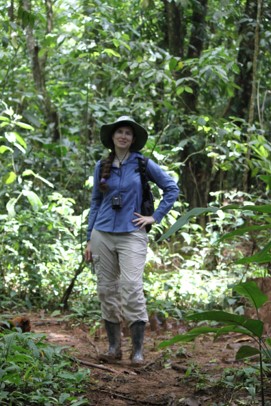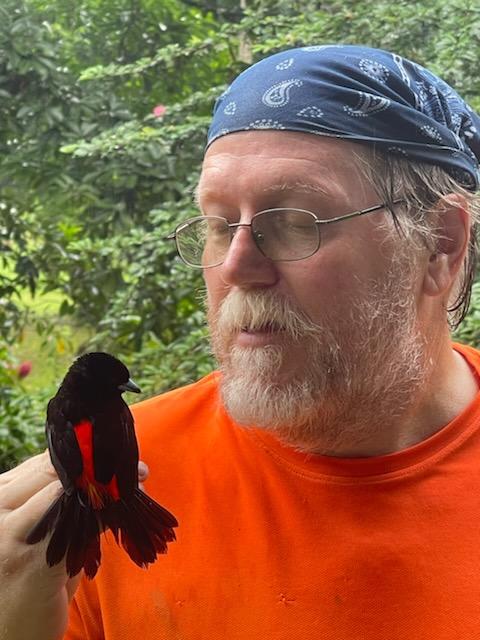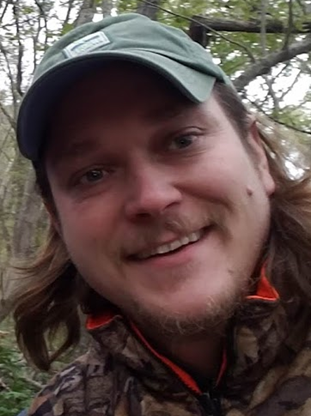People
MRC Staff

Renee Molina, Director
info@maderasrfc.org
I am the Director of Maderas Rainforest Conservancy. The rainforest has been a part of me since an early age. I grew up playing in rainforest rivers and streams in the mountains of northern Nicaragua my birthplace. I have been working in conservation since 1995. I started teaching art in the rainforest, a site specific sculpture seminar in which students learn to apply materials and techniques to generate site specific work in the Rainforest. I have traveled to Central America extensively and understand the needs of rural rainforest communities on many levels. My training is in Architecture and hold Masters degree from the Ohio State University. Although i’m not a scientist architecture has given me a multidimensional approach at looking at the world and how to make positive impacts in poor rural rainforest communities.
Instructors

Dr. Laura Bolt
laura.bolt@mail.utoronto.ca
Dr. Laura Bolt is a primatologist who holds degrees from the University of Cambridge (UK), University of Toronto, and Queen’s University (Canada). Her research interests include primate vocal communication, primate behavioral ecology, and forest fragmentation. Dr. Bolt’s research is of broad interest to the general public and has received international media attention, with
coverage by news agencies including National Geographic, Reuters, the UK’s Daily Mail, and Science Daily.
As co-director of the La Suerte Forest Fragmentation and Primate Behavioral Ecology Project, Dr. Bolt’s current research focuses on mantled howler monkey (Alouatta palliata), white-faced capuchin monkey (Cebus capucinus) and Central American spider monkey (Ateles geoffroyi) behavioral ecology in a fragmented tropical rainforest in Costa Rica.
Dr. Bolt’s published and ongoing work also focuses on vocalization usage in the ring-tailed lemur (Lemur catta), a basal primate endemic to Madagascar that is one of the best living models of gregarious primate ancestors. Dr. Bolt studies communication behaviour in wild lemurs at Beza Mahafaly Special Reserve, Madagascar, with the goal of better understanding the evolution of cognition in the primate order and identifying which traits may be fundamental. Dr. Bolt’s work to date has demonstrated the complexity and sophistication of communication systems in a basal strepsirhine primate.
As an experienced university lecturer, Dr. Bolt has taught courses at the University of Toronto, University of Toronto Mississauga, University of Waterloo, and OCAD University (Toronto, Canada) ranging from introductory topics in biology and biological anthropology to advanced seminar classes. Dr. Bolt consistently receives outstanding teaching evaluations. She has led primate field courses for Maderas Rainforest Conservancy since 2014 in Costa Rica and Nicaragua.

Dr. LaRoy Brandt
LaRoy.Brandt@lmunet.edu
Although my educational background suggests a certain affinity toward insects, my research experience and interests are quite eclectic to say the least. Overall, I would consider myself an organismal biologist and general ecologist with an emphasis in conservation. I have particular interests in biodiversity, conservation ecology, and environmental health. These interests include tropical forest ecology and conservation, water quality in temperate and tropical regions, impacts of habitat fragmentation on biodiversity, as well as the science of teaching and learning. Currently, I am particularly interested in the utility of occupancy modeling to address ecological and conservation questions across a variety of applications.
Publications (for a full list click Faculty Bio)
- Brandt, L.S.E. 2012. Broader Impacts of Undergraduate Research at a Community College: Opening Doors to New Ideas. Council for Undergraduate Research Quarterly 33(1):17-21.
- Brandt, L. S. E., B. Ludwar, and M. D. Greenfield. 2005. Co-occurrence of preference functions and acceptance thresholds in female choice: mate discrimination in the lesser was moth. Ethology 111 (6), 609-625.
- Brandt, L. S. E., and M. D. Greenfield. 2004. Condition-dependent traits and the capture of genetic variance in male advertisement song, (Lepidoptera: Pyrallidae: Achroia grisella). Journal of Evolutionary Biology 17 (4), 821-828.
- Sandidge, J. S., and L. S. E. Brandt. 2003. Individual Identification and Nocturnal Observation of Small Arthropods Using Fluorescent Powders. Journal of Kansas Entomological Society 76 (3), 417- 425.

Dr. Tanja McKay
Dr. Tanja McKay is a Professor of Entomology in the Department of Biological Sciences at Arkansas State University and is the Director of the Environmental Sciences Graduate Program. She is also the Interim Director of the Molecular Biosciences Graduate Program. She teaches and does most of her research in the field of medical/veterinary entomology and stored-product entomology. She is originally from Nova Scotia, Canada where she received her B.S. degree from Acadia University, Wolfville, Nova Scotia. She moved to Winnipeg Manitoba in 1995 to pursue a MS degree in Entomology where she studied the biological control of house flies in dairy operations. In 2002, she received her Ph.D. in Entomology from Kansas State University. For her dissertation, she studied the behavior of a small parasitic wasp that parasitizes house flies. She examined the behavior of these wasps and addressed fundamental questions that may lead to an improvement in their effectiveness.
After completing her dissertation, she joined the staff in the Department of Entomology at the University of Arkansas as a Research Associate in Veterinary Entomology where she conducted research in broiler-breeder egg production and turkey finishing facilities. She evaluated filth fly monitoring systems and identified pathogens of food quality importance (Campylobacter, Salmonella, E. coli, and Shigella) carried by flies using traditional culturing techniques and PCR diagnostics. In August, 2004, she joined the faculty at Arkansas State University. She currently teaches 11 lecture and laboratory courses at A-State including General Entomology, Medical/Veterinary Entomology and Insect Taxonomy. Her current research interests include examining dog heartworm associations in mosquitoes; examining nematode and fungal associations in mosquito larvae for potential biological control; studying dung beetle ecology in Arkansas; forensic entomology and examining the spatial and temporal distribution of stored-product insects of stored rice.

Amo Oliverio
anthony.oliverio@easternwv.edu
An instructor and coordinator of the Biological and Environmental Technology (B.E.T.) program Eastern WV Community and Technical College. Mr. Oliverio has co-taught Garrett College’s Natural History at La Suerte since 2009 and traveled to Costa Rica, Nicaruagua, and Peru many times since 2008 to study neotropical biodiversity. He is thoroughly fascinated by nature’s biodiversity and ecological relationships and passionate about inspiring students with hands-on learning and experiences in the natural environment. At La Suerte Biological Field Station, he is interested in the biodiversity of reptiles, amphibians, birds, and mammals. A new focus is the dynamics of the endangered Baird’s tapir (Tapirus bairdii) population at the station.
Education:
- Chemical and Life Science, M.S. – University of Maryland
- Wildlife Biology, B.S. – Frostburg State University
- Natural Resources and Wildlife Technology, A.A.S. – Garrett College

Dr. Amy Schreier
aschreier@regis.edu
My primary area of research is the behavioral ecology of non-human primates. I am currently studying mantled howler monkeys and capuchin monkeys at La Suerte Biological Field Station in Costa Rica where I am investigating the relationship between life history and juvenile development. In collaboration with Dr. Marie-do Franco, we are examining the influence of habitat fragmentation on dispersal and genetic polymorphism in these species by collecting and analyzing DNA samples from individual monkeys.
Students can participate in my research by traveling to Costa Rica and studying howler monkeys and capuchins in the wild, or working here on campus in the genetics lab. Students can also conduct studies using data I have previously collected on hamadryas baboons and lemurs.
Publications (for a full list click Faculty Bio)
- Barrickman, N., Schreier, A.L., Glander, K.E. (2015) Testing parallel laser image scaling for remotely measuring body dimensions on mantled howling monkeys (Alouatta palliata). American Journal of Primatology 77: 823-832.
- Schreier, A.L., Grove, M. (2014) Recurrent patterning in the daily foraging routes of hamadryas baboons (Papio hamadryas): Spatial memory in large-scale versus small-scale space. American Journal of Primatology 76: 421-435.
- Schreier, A.L., Swedell, L. (2012) Ecology and sociality in a multilevel society: ecological determinants of social cohesion in hamadryas baboons. American Journal of Physical Anthropology 148: 580-588.
- Schreier, A.L., Swedell, L. (2012) The socioecology of network scaling ratios in the multilevel society of hamadryas baboons. International Journal of Primatology 33: 1069-1080.
Ready to Attend?
Apply NowQuestions?
Fill out this contact form and we’ll get back to you as soon as we can. In the meantime check out our FAQ!
